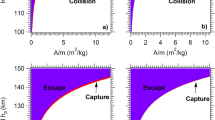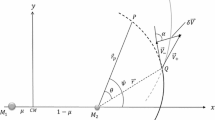Abstract
The swing-by maneuver is a technique used to change the energy of a spacecraft by using a close approach in a celestial body. This procedure was used many times in real missions. Usually, the first approach to design this type of mission is based on the “patched-conics” model, which splits the maneuver into three “two-body dynamics.” This approach causes an error in the estimation of the energy variations, which depends on the geometry of the maneuver and the system of primaries considered. Therefore, the goal of the present paper is to study the errors caused by this approximation. The comparison of the results are made with the trajectories obtained using the more realistic restricted three-body problem, assumed here to be the “real values” for the maneuver. The results shown here describe the effects of each parameter involved in the swing-by. Some examples using bodies in the solar system are used in this part of the paper. The study is then generalized to cover different mass parameters, and its influence is analyzed to give an idea of the amount of the error expected for a given system of primaries. The results presented here may help in estimating errors in the preliminary mission analysis using the “patched-conics” approach.









Similar content being viewed by others
Notes
A fourth-order Runge–Kutta method with monotoring of local truncation error to fifth order was used to ensure accuracy and to adjust stepsize.
The spacecraft never passes too close to the center of the bodies, so regularization is not required to solve this problem.
The dashed red and solid black lines are superposed in almost all figures contained in Fig. 4, due to the symmetry of the problem (in other words: \(max(\Delta E_\mathrm{error})=-min({\Delta E}_\mathrm{error})\)). The exception is for \(\alpha \), which is precisely the variable that creates this symmetry.
The greater errors for lower \(r_p\) and N, for \(\alpha =90\) and \(270^\circ \) , etc., the symmetries.
The percentage is around 15\(\%\) for Jupiter and 6\(\%\) for the Earth.
References
Araujo, R.A.N., Winter, O.C., Prado, A.F.B.A., Vieira Martins, R.: Sphere of influence and gravitational capture radius: a dynamical approach. Mon. Not. R. Astron. Soc. 391, 675–684 (2008)
Broucke, R.: The celestial mechanics of gravity assist. In: Astrodynamics Conference, Guidance, Navigation, and Control and Co-located Conferences (1988)
Broucke, R.A., Prado, A.F.B.A.: Jupiter swing-by trajectories passing near the Earth. Adv. Astronaut. Sci. 82, 1159–1176 (1993)
Byrnes, D.V., Damario, L.A.: A combined Halley flyby/Galileo mission. Astrodynamics 1, 1–10 (1982)
Dowling, R., Kosmann, W., Ridenoure, R.: Gravity propulsion research at UCLA and JPL 1962–1964. In: IAF, International Astronautical Congress, 42 nd, Montreal, Canada (1991)
Farquhar, R.W., Dunham, D.W.: A new trajectory concept for exploring the Earth’s geomagnetic tail. J. Guid. Control Dyn. 4, 192–196 (1981)
Flandro, G.: Fast reconnaissance missions to the outer solar system utilizing energy derived from the gravitational field of jupiter. Earth 108, 6-1 (1966)
Gomes, V.M., Prado, A.F.B.A.: Swing-by maneuvers for a cloud of particles with planets of the Solar System. WSEAS Trans. Appl. Theor. Mech. 3, 869–878 (2008)
Grard, R.: Mercury: the Messenger and BepiColombo missions A concerted approach to the exploration of the planet. Adv. Space Res. 38, 563 (2006)
Greenberg, R., Carusi, A., Valsecchi, G.B.: Outcomes of planetary close encounters: a systematic comparison of methodologies. Icarus 75(1), 1–29 (1988)
Hollister, W.M., Prussing, J.E.: Optimum transfer to Mars via Venus (Transfer paths to Mars via Venus compared with direct flight, discussing direct free fall transfer, flyby and free fall transfer). Astronaut. Acta. 12, 169–179 (1966)
Jehn, R., et al.: Navigating BepiColombo during the weak-stability capture at Mercury. Adv. Space Res. 42, 1364–1369 (2008)
Longuski, J.M., Williams, S.N.: The last grand tour opportunity to Pluto. J. Astronaut. Sci. 39, 359–365 (1991)
Mcnutt, R.L., Solomon, S.C., Grard, R., Novara, M., Mukai, T.: An international program for Mercury exploration: synergy of MESSENGER and BepiColombo. Adv. Space Res. 33, 2126–2132 (2004)
Mcnutt, R.L., Solomon, S.C., Gold, R.E., Leary, J.C.: The MESSENGER mission to Mercury: development history and early mission status. Adv. Space Res. 38, 564–571 (2006)
Minovich, M.A.: A method for determining interplanetary free-fall reconnaissance trajectories. JPL Tec. Memo 312, 130 (1961)
Patel, M.R., Longuski, J.M., Sims, J.A.: A Uranus–Neptune–Pluto opportunity. Acta Astronaut. 36, 91–98 (1995)
Penzo, P.A.: A multi-mission flyby strategy for the near-earth asteroids. In: AIAA/AAS Astrodynamics Conference, pp. 89–95 (1992)
Perozzi, E.: Cassini Mission: Dynamics of the Titan Close Encounter, vol. 242. ESA Special Publication, Paris (1986)
Perozzi, E., Rossi, A., Valsecchi, G.B.: Basic targeting strategies for rendezvous and flyby missions to the near-Earth asteroids. Planet. Space Sci. 49, 3–22 (2001)
Prado, A.F.B.A.: An analytical description of the close approach maneuver in three dimensions. In: 51th International Astronautical Congress (2000)
Prado, A.F.B.A.: A comparison of the patched-conics approach and the restricted problem for swing-bys. Adv. Space Res. 40, 113–117 (2007)
Prado, A.F.B.A., Felipe, G.: An analytical study of the powered swing-by to perform orbital maneuvers. Adv. Space Res. 40(1), 102–112 (2007)
Sohn, R.L.: Venus swingby mode for manned Mars missions. J. Spacecr. Rockets 1, 565–567 (1964)
Sohn, R.L.: Manned Mars trips using Venus flyby modes. J. Spacecr. Rockets 3, 161–169 (1966)
Solorzano, C.R.H., Sukhanov, A.A., Prado, A.F.B.A.: A study of trajectories to the Neptune system using gravity assists. Adv. Space Res. 40, 125–133 (2007)
Stern, A.: The Pluto reconnaissance flyby mission. Eos Trans. Am. Geophys. Union 74, 73–78 (1993)
Szebehely, V.G.: Theory of Orbits. Academic, New York (1967)
Weinstein, S.S.: Pluto flyby mission design concepts for very small and moderate spacecraft. In: AIAA/AAS Astrodynamics Conference, pp. 76–88 (1992)
Yamakawa, H., et al.: Frequent access to Mercury in the early 21st century: multiple Mercury flyby mission via electric propulsion. Acta Astronaut. 39, 133–142 (1996)
Yen, C.L.: Ballistic Mercury orbiter mission via Venus and Mercury gravity assists. J. Astronaut. Sci. 37, 417–432 (1989)
Acknowledgements
A special thanks to the reviewers for the ideas that put this paper in a broader context. Also, the author thanks the Grants \(\#\) 406841/2016-0 and 301338/2016-7 from the National Council for Scientific and Technological Development (CNPq), and Grants \(\#\) 2011/08171-3, 2011/13101-4, 2015/24321-6 and 2016/14665-2 from São Paulo Research Foundation (FAPESP).
Author information
Authors and Affiliations
Corresponding author
Rights and permissions
About this article
Cite this article
Negri, R.B., Prado, A.F.B.d.A. & Sukhanov, A. Studying the errors in the estimation of the variation of energy by the “patched-conics” model in the three-dimensional swing-by. Celest Mech Dyn Astr 129, 269–284 (2017). https://doi.org/10.1007/s10569-017-9779-3
Received:
Revised:
Accepted:
Published:
Issue Date:
DOI: https://doi.org/10.1007/s10569-017-9779-3




